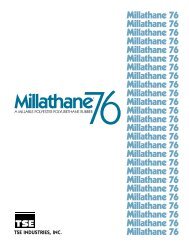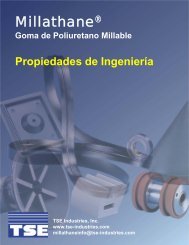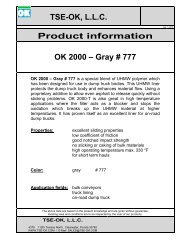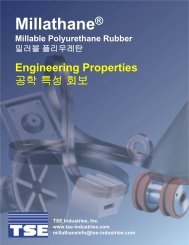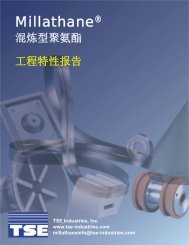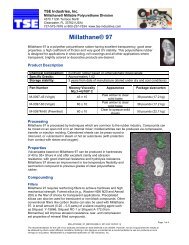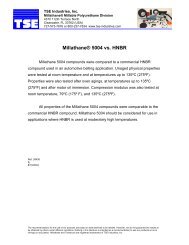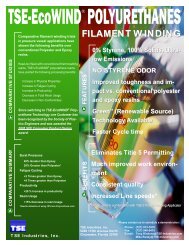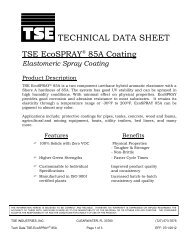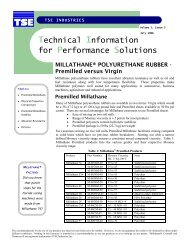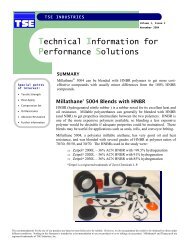Compounding Millathane 26 TIPS V6-2 - TSE Industries, Inc.
Compounding Millathane 26 TIPS V6-2 - TSE Industries, Inc.
Compounding Millathane 26 TIPS V6-2 - TSE Industries, Inc.
Create successful ePaper yourself
Turn your PDF publications into a flip-book with our unique Google optimized e-Paper software.
<strong>TSE</strong> INDUSTRIES<br />
Volume 6, Issue 2<br />
November 2009<br />
Technical Information<br />
for Performance Solutions<br />
Topics:<br />
• <strong>Millathane</strong>® <strong>26</strong> Blends with High<br />
Styrene Resin and Liquid<br />
Polybutadiene<br />
• High Styrene Resin (Pliolite S6B)<br />
Blends<br />
• Liquid Polybutadiene Resin in<br />
<strong>Millathane</strong>® <strong>26</strong><br />
• Summary<br />
• ASK Doctor <strong>Millathane</strong><br />
<strong>Millathane</strong>® <strong>26</strong> Blends with High Styrene<br />
Resin and Liquid Polybutadiene<br />
<strong>Millathane</strong> <strong>26</strong> is the only millable polyurethane rubber that complies with the FDA<br />
regulation 21CFR177.<strong>26</strong>00 and has found use in various applications involving food<br />
contact. As some applications, including rollers and gaskets, require relatively high<br />
hardnesses, several formulation ingredients were evaluated to achieve these higher<br />
hardnesses.<br />
This report examines compounding of <strong>Millathane</strong> <strong>26</strong> with Pliolite S6B (a high styrene<br />
resin) and Ricon 154 (a polybutadiene resin). These materials, as well as the other<br />
ingredients in the formulations shown here, comply with the FDA regulation<br />
21CFR177.<strong>26</strong>00*.<br />
High Styrene Resin (Pliolite S6B) Blends<br />
Pliolite S6B is an emulsion polymerized high styrene resin with a typical<br />
styrene/butadiene ratio of 82.5/17.5. It is commonly used to increase hardness and<br />
stiffness in rubber compounds that are used for various applications including shoe<br />
soles, rollers, etc.<br />
As a means to achieve high hardness <strong>Millathane</strong> <strong>26</strong> compounds, Pliolite S6B was<br />
blended with <strong>Millathane</strong> <strong>26</strong> in ratios from 100/0 to 70/30 <strong>Millathane</strong> <strong>26</strong>/Pliolite S6B.<br />
The non-black, silica reinforced formula is shown below:<br />
<strong>Millathane</strong> <strong>26</strong> 100 – 70<br />
Pliolite S6B 0 – 30<br />
Stearic acid 0.3<br />
Ultrasil VN3 25<br />
TP-95 (DBEEA) 2<br />
Struktol WB222 1<br />
AC 617A 2<br />
Dicumyl peroxide 40% 5<br />
The data, shown in the following two charts, show the following trends:<br />
• Hardness and tensile stress (aka, modulus) increased as the level of Pliolite S6B<br />
increased. The hardness increased approximately 8 Shore A points per 10 parts<br />
Pliolite S6B. The highest hardness of these compounds tested 86 Shore A.<br />
• Tensile strength decreased somewhat with increasing Pliolite S6B, approximately<br />
400 psi (2.7 MPa) per 10 parts Pliolite S6B.<br />
• Abrasion resistance was not affected up to 10 phr Pliolite S6B but was somewhat<br />
poorer at higher levels.<br />
*with information as provided by suppliers of the ingredients, as of November 2009. You should check with the suppliers of your<br />
raw materials to confirm that they are (still) FDA-compliant.<br />
The recommendations for the use of our products are based on tests believed to be reliable. However, we do not guarantee the results to be obtained by<br />
others under different conditions. Nothing in this literature is intended as a recommendation to use our products so as to infringe on any patent. <strong>Millathane</strong>®<br />
and Thanecure® are registered trademarks of <strong>TSE</strong> <strong>Industries</strong>, <strong>Inc</strong>.
Page 2<br />
<strong>TIPS</strong><br />
Resilience decreased slightly and compression set increased slightly as the Pliolite S6B level<br />
increased.<br />
Other data not shown here indicated that, as the level of Pliolite S6B increased, the viscosity<br />
was relatively constant and the tear resistance (both Die C and Die B) was improved.<br />
MPa psi<br />
24.5 3500<br />
<strong>Millathane</strong>® <strong>26</strong> with Pliolite S6B<br />
Hardness and Stress/Strain Properties<br />
100<br />
150<br />
<strong>Millathane</strong>® <strong>26</strong> with Pliolite S6B<br />
Resilience, DIN Abrasion and Compression Set<br />
DIN Abrasion, mm³ loss<br />
21 3000<br />
17.5 2500<br />
14 2000<br />
10.5 1500<br />
7 1000<br />
Hardness<br />
90<br />
80<br />
70<br />
60<br />
50<br />
Hardness, Shore A<br />
120<br />
90<br />
60<br />
Bashore Resilience, %<br />
Compression Set, 22 hr/70°C, % set<br />
3.5<br />
500<br />
40<br />
30<br />
0<br />
0 5 10 15 20 30<br />
% Pliolite S6B<br />
<strong>TSE</strong>-100* <strong>TSE</strong>-300 Tensile Strength Hardness<br />
30<br />
0<br />
0 5 10 15 20 30<br />
% Pliolite S6B<br />
*<strong>TSE</strong>-XXX = Tensile Stress at XXX Elongation<br />
MILLATHANE® FACTOID:<br />
Transparent<br />
<strong>Millathane</strong>® 97<br />
compounds,<br />
containing UV<br />
stabilizers, showed no<br />
signs of crazing or<br />
cracking after 29<br />
months outdoors in<br />
Clearwater, FL.<br />
Liquid Polybutadiene Resin in <strong>Millathane</strong>® <strong>26</strong><br />
Liquid polybutadiene resins, such as Ricon 154 from Sartomer Company, can be used as<br />
vulcanizable coagents in <strong>Millathane</strong> <strong>26</strong>. Ricon 154 is a butadiene homopolymer with 1,2-Vinyl<br />
content of 90%. An experimental design was run, varying the precipitated silica (Ultrasil VN3)<br />
from 25 to 50 parts while varying the polybutadiene resin (Ricon 154) from 0 to 10 parts.<br />
<strong>Millathane</strong> <strong>26</strong> 100<br />
Stearic acid 0.3<br />
Ultrasil VN3 25 – 50<br />
TP-95 (DBEEA) 2<br />
Struktol WB222 1<br />
Ricon 154 0 – 10<br />
Dicumyl peroxide 40% 5<br />
The data, plotted in the contour charts below, show:<br />
• The hardness is primarily affected by the silica level, increasing approximately 4 Shore A<br />
points for each 7-8 parts of silica. The polybutadiene resin also increased the hardness,<br />
about 4 Shore A points per 10 parts of resin.<br />
• The compound viscosity is significantly affected by both the silica and the polybutadiene<br />
resin, increasing with increasing silica, and decreasing with increasing polybutadiene<br />
resin.<br />
• The tensile strength is not significantly affected by either ingredient, with all compounds<br />
in this experimental design testing between 3140 and 3650 psi (21.7 to 25.2 MPa)<br />
tensile strength.<br />
Abrasion resistance was not significantly affected by the polybutadiene resin levels, but did<br />
diminish somewhat as the silica level increased, giving higher DIN abrasion losses.
<strong>TIPS</strong><br />
Page 3<br />
MILLATHANE®<br />
FACTOID: Adding<br />
Thanecure® T9 to<br />
sulfur or peroxide<br />
cured <strong>Millathane</strong> will<br />
increase compound<br />
hardness with other<br />
properties minimally<br />
affected.<br />
Summary<br />
High hardness compounds based upon <strong>Millathane</strong> <strong>26</strong> can be achieved by increasing the silica<br />
(or carbon black) level in the compound, although this, by itself, will give tend to give high<br />
viscosity compounds. The addition of high styrene resin (Pliolite S6B) or liquid polybutadiene<br />
resin (Ricon 154), along with the reinforcing filler, will give better processing (lower viscosity)<br />
compounds than just using reinforcing filler to increase hardness.<br />
MILLATHANE®<br />
FACTOID: If you’re<br />
trying to replace<br />
CSM (Hypalon®*)<br />
in a compound,<br />
consider<br />
<strong>Millathane</strong> millable<br />
urethanes!<br />
Contact us for<br />
more information.<br />
Although not evaluated yet, the combination of high styrene resin and liquid polybutadiene<br />
resin in <strong>Millathane</strong> <strong>26</strong> compounds may give optimum compounds at moderately high<br />
hardnesses. Please contact us for a formulation recommendation for your particular<br />
application.
<strong>TIPS</strong><br />
<strong>TSE</strong> INDUSTRIES<br />
4370 112th Terrace North<br />
Clearwater, FL , USA 33762-4902<br />
Toll Free: 800-237-7634<br />
Phone: 727-573-7676<br />
Fax: 727-572-0487<br />
E-mail: millathaneinfo@tse-industries.com<br />
www.tse-industries.com<br />
We are here to serve you:<br />
Tom Jablonowski, Technical Service Manager<br />
tom.jablonowski@tse-industries.com<br />
Jim Nina Ahnemiller, Manee, Sales Technical & Marketing Director Representative nina.manee@tse-industries.com<br />
jim.ahnemiller@tse-industries.com<br />
Jerry Nina Manee, McCall, Global Sales & Business Marketing Director Representative of<br />
nina.manee@tse-industries.com<br />
jerry.mccall@tse-industries.com<br />
Jerry McCall, Director <strong>Millathane</strong> of Sales and Thanecure & Marketing jerry.mccall@tse-industries.com<br />
Technology / Service /<br />
Experience<br />
An ISO 9001:2000<br />
Certified Company<br />
ASK Doctor <strong>Millathane</strong> ®<br />
Dear Dr. <strong>Millathane</strong>,<br />
I have an application that required a low density urethane material. Can I make sponge or<br />
foamed rubber using <strong>Millathane</strong> millable urethanes<br />
Dennis Sittie<br />
Hi, Den Sittie,<br />
Yes, you can make expanded/sponge compounds from <strong>Millathane</strong> millable urethanes, although maybe not in the<br />
way you’d expect. The typical method of making sponge compounds is to add a chemical blowing or foaming<br />
agent (CBA or CFA) which, when it decomposes during curing, generates nitrogen or carbon dioxide. Unfortunately,<br />
these chemicals tend to be difficult to work with in millable urethanes as the chemicals affect the curing of the<br />
urethane.<br />
A fairly recent development is the use of expandable microspheres (e.g., Expancel ®* ) as the expansion agent.<br />
These materials are very small polymeric spheres that contain an expandable hydrocarbon gas. Upon heating, the<br />
gas, and correspondingly the polymeric sphere, expands in the rubber compound, giving a lower density cured<br />
compound.<br />
An example of this technology is a <strong>Millathane</strong> 97 compound containing 5 parts of Expancel 930DU120. This<br />
compound, molded for 4 minutes at 170ºC, tested 41 Shore A and 62 Asker C hardness, and had a density of<br />
0.53 g/cc. A micrograph of the sponge is shown below. Please let us know if you have any specific requirements<br />
in this area, as we’re currently doing some further evaluations of these materials.<br />
Dr. <strong>Millathane</strong><br />
<strong>Millathane</strong>® 97 Sponge (4x)<br />
*Expancel is a trademark of Akzo Nobel, and<br />
Hypalon is a trademark of DuPont<br />
If you have any <strong>Millathane</strong> millable urethane questions you’d like answered, please send an email to millathaneinfo@tse-industries.com.



